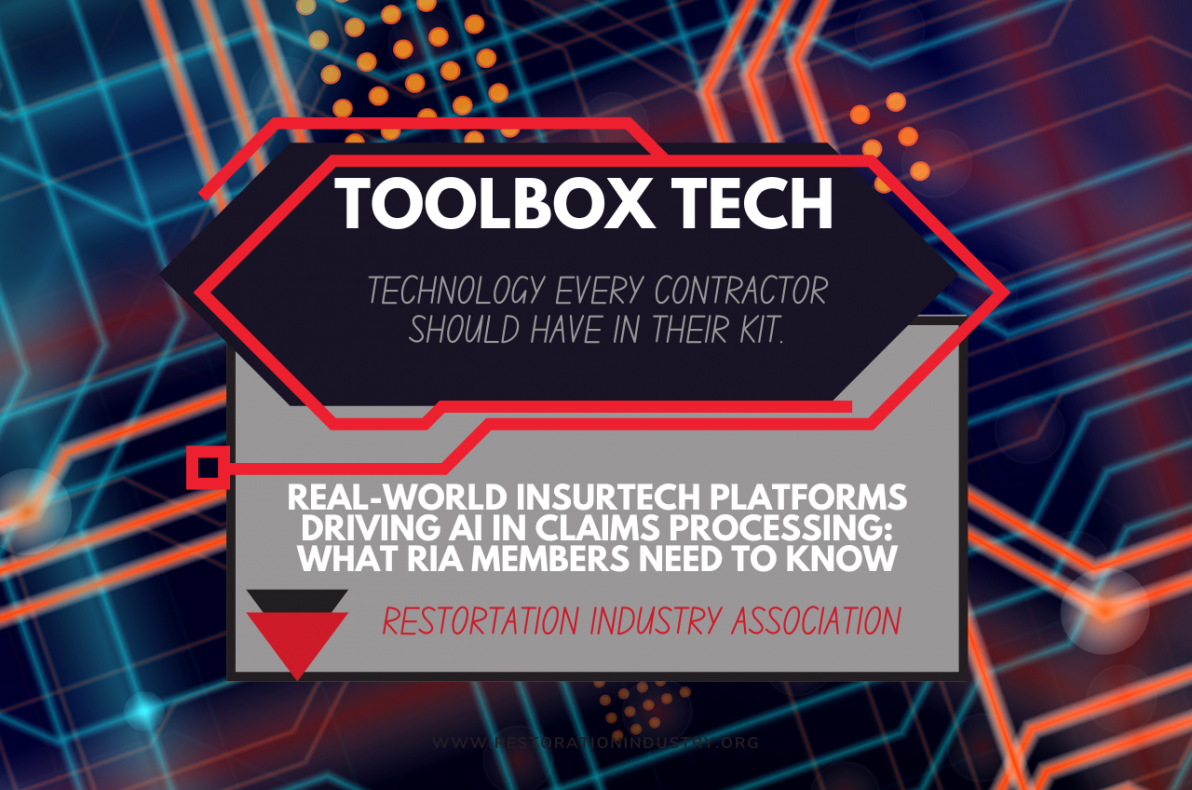Real-World Insurtech Platforms Driving AI in Claims Processing: What RIA Members Need to Know

As artificial intelligence (AI) continues to reshape industries, the insurance and property restoration sectors are seeing rapid adoption of advanced technologies designed to streamline claims handling. For restoration professionals, understanding these changes isn't just helpful—it's essential. From automating claim estimates to analyzing property damage through images, Insurtech platforms are reshaping how losses are assessed, priced, and paid.
Here's a closer look at some of the key platforms driving this transformation, and what restoration contractors need to know to stay informed and protect their interests.
Key Insurtech Platforms to Watch
IBM® Content and Predictive Analytics for Claims
IBM's claims analytics platform combines predictive modeling with unstructured data analysis (like adjuster notes and claim documents) to streamline decisions and flag potential fraud. It supports adjusters in making faster, more consistent decisions and enables automation in areas traditionally handled manually.
Source: IBM Predictive Analytics for Claims Overview
Guidewire ClaimCenter®
Guidewire is widely used by major insurers as a core claims management system. Its AI-driven capabilities allow for automation of workflows, claim triage, and seamless integration with third-party analytics tools. Guidewire supports carriers in managing high claim volumes while reducing manual errors.
Source: Guidewire ClaimCenter Product Overview
CCC Intelligent Solutions
CCC Intelligent Solutions is a leading SaaS platform serving the property and casualty insurance economy, offering a wide range of AI-powered capabilities, including image analysis, smart estimating tools, and automated claims workflows. One of its notable innovations is the CCC® Safekeep platform—an AI-powered subrogation solution recognized with the 2022 IDC FinTech Rankings Real Results Award for Efficiency and Agility. The platform, used by carriers like Root Insurance, applies machine learning, natural language processing, and predictive analytics to streamline subrogation identification and improve recovery outcomes. CCC's broader ecosystem of solutions is helping insurers automate and enhance various aspects of claims management. Source: CCC Press Release - IDC FinTech Award. Their Smart Estimate® and Smart Audit® tools use AI to create damage estimates from photos and assess invoices with speed and accuracy. CCC's solutions are becoming increasingly integrated into carriers' workflows.
*Source: *CCC Data + AI: The Intelligent Edge
Xactware (a Verisk business)
Xactware’s tools—including Xactimate and XactAnalysis—remain central to estimating property loss. Verisk emphasizes building trust in AI-driven claims, implementing ethical frameworks, data transparency, and human oversight to ensure fairness and accountability. Their recent efforts include deploying a formal AI code of conduct and governance model that ensures AI systems are responsibly designed and utilized in claim assessments. Restoration contractors should know that Verisk’s AI-driven enhancements are not just about speed—they’re also about reinforcing trust, data integrity, and ethical decision-making in the claims process.
Source:Building Trust in AI-Driven Claims Handling: A Deeper Look at Data and Ethics
Why This Matters to Restoration Professionals
Many of these platforms are marketed as tools to improve accuracy, efficiency, and customer satisfaction—and they do offer those advantages. But they also introduce new dynamics that can affect contractor pricing, scope negotiation, and claim outcomes. Some AI-driven systems:
- Flag certain line items for denial based on historical data patterns.
- Rely on regional or outdated pricing benchmarks.
- Produce estimates with limited visibility into project complexity or unique conditions.
As AI becomes more embedded in claims processing, restoration professionals must:
- Understand how these platforms influence claim outcomes.
- Ensure their documentation supports fair pricing and project-specific nuances.
- Request transparency from carriers on how AI tools are being used in the estimate review process
What RIA's AGA Is Doing About It
The RIA's Advocacy and Government Affairs (AGA) Committee is working proactively to address these emerging challenges. Here’s how:
- Monitoring industry AI adoption trends and engaging with regulators and stakeholders to promote transparency.
- Defending contractor rights and pushing back on overly rigid AI-generated cost models.
- Providing guidance and tools to help restoration professionals respond to AI-influenced denials and adjuster decisions.
By staying informed and working together, the restoration industry can help shape how AI is implemented, ensuring it enhances efficiency without compromising fairness.
Additional Reading
- Roots.ai: State of AI Adoption in Insurance (2025 Report) — This in-depth study provides a comprehensive overview of where insurers stand on AI usage, priorities, and barriers to adoption.
- RIA Blog: How to Protect Yourself Against AI-Driven Claim Reductions by Doug Weatherman — Learn how to navigate AI in claims and advocate for fair outcomes.
Bottom Line AI is here to stay in the insurance space. For restoration contractors, understanding how these tools work—and how to respond effectively—is key to ensuring fair claim outcomes and maintaining professional autonomy.
Stay connected with RIA and the AGA for the latest updates, tools, and advocacy efforts on this evolving topic.
